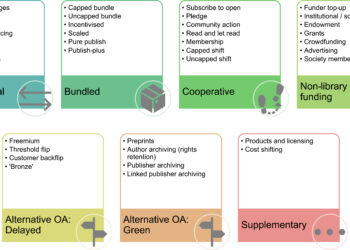
There is a very good piece on the AAUP Web site about some developments in the university press world concerning so-called short-form publishing. Long-form means book length. Something is short-form when it is longer than an article and less than a book. In fiction we would call this a novella, but we don’t really have a term for this for nonfiction, unless we go back in time and raise the specter and form of the pamphleteers of the 18th century. O Thomas Paine, where art thou?
The short form (which is really a middle form, since articles are shorter yet) has been mostly dormant for decades because the circumstances of profitable publishing in the print era could not make an economic case for the short form. Book-length work could be sold in bookstores, where it commanded a price (in today’s currency) between $12 and $25. Articles could find a place in journals or in collections of essays (sold as a book). But what to do about the 40,000-word essay? How to price it? So much of the cost of getting a book into a bookstore is in handling and transportation, so a 40,000-word piece would have to bear a price close to that of a full book. Which doesn’t make much sense if you are a customer. Thus, the short form languished — until now, when digital technology opens up new possibilities.
Different publishers will explore “shorts” in different ways. There are basically three approaches:
- Start with a full-length book (a “long”) and then take sections or chapters out of it and publish them as a separate work, usually in digital form. This approach is often called “chunking,” whereby the publisher sells the book in pieces or chunks.
- Start with a full-length book and then rewrite it to make it shorter, presumably to reach a different audience. This is a lot of work, which is why chunking is more common. An outstanding example of the rewriting method is “Christopher Columbus, Mariner” by Samuel Eliot Morrison, a slimmed-down rewriting of Morrison’s Pulitzer-prize winning “Admiral of the Ocean Sea.”
- Create a short from scratch. This has the most imaginative appeal, but there are business issues here, which we will get to in a moment.
For academic publishers, the first strategy (chunking) slyly opens up an intriguing business opportunity. Let’s say a university press publishes a monograph of some 400 pages. After the book has been out for a couple years, an instructor wants to use part of it in the classroom. The original edition was a high-priced hardcover, costing perhaps $50. But there is now a $20 paperback, which was created with students in mind. But even at $20, many students resist the purchase, especially if they only have to read 50 pages out of 400. So they buy the book used or find unauthorized copies online. Neither action benefits the publisher.
A short digital edition, however, could change a student’s calculations. The short of, say, 70 pages can be sold for $4.95 or $7.95 as an e-book. That’s less than the publisher may want, but it’s better than having the book pirated. It’s also too short a version to prompt a library to purchase the short instead of the full text. In other words, the long-form text is targeted to faculty through the library, and the short is targeted to the student. By implementing shorts in this way, academic publishers continue to support their higher-priced complete editions, work multiple sales channels (libraries and students), undercut the sale of used books, and dampen piracy. This is first-rate tactical marketing, and the presses who figured this out are to be commended for their acumen.
The second option, rewriting a long book in shorter form, is not so attractive, though it will no doubt continue to tempt many academics as it has for years. What’s at issue here is popularization. This is what Samuel Morrison was after in the example above. “Christopher Columbus, Mariner” appears to have been written with a young readership in mind. While Dad sits in his study with the full-length masterpiece (I did this myself many years ago), Junior can pick up the shorter book and learn about Renaissance navigation and the European contact with the peoples of the Western Hemisphere. I read the shorter book as well for professional reasons when I was the editor of the Meridian imprint, which published it. It’s a great book, though I could not get my kids to read it (“Bor-ing!”).
But nothing will stop some academics from dreaming of popular success. Having researched a topic thoroughly and published the findings to professional acclaim, they seek to become celebrities, with a book on the bestseller list and invitations to all the TV talk shows. While there are some high-profile exceptions to the rule, this story usually ends badly. People who write for a wide audience are born that way; it’s like being popular in high school: either you are or you aren’t. I would discourage academic publishers from using shorts in this way. Trade publishing is not “academic publishing light” but a different kind of publishing altogether.
As for writing original shorts, well, we would all like this to happen, would we not? The problem is with marketing–or, as it is more often called nowadays, discovery. How do you bring a short work to the attention of a wide readership? A short is going to have to be digital-only because there are no bricks-and-mortar venues to support its sale, and discovery for online products is very difficult because of the sheer quantity of available material, some small portion of which may actually be worth reading. How to be heard above the noise?
A chunked short (the first category above) doesn’t have this problem because it can trade on the reputation of the full-length book, but an original short enters the world alone, unable to command a big marketing budget because the revenue opportunity for any one short is so small. To be able to market shorts effectively, new marketing methods will have to be invented. A Netflix for shorts, perhaps? Or perhaps a subscription to shorts? But isn’t that taking us in the direction of a journal? I think this problem will be solved in time, but it will not be easy. Consider spoken-word audio, for example. There is a sizable market for audio versions of popular books, but almost no market for audio originals. It’s hard to get readers’ (listeners’) attention for stand-alone audio, which is precisely the problem that original shorts face.
What’s important to realize about shorts is that they are native to digital media. We have only been working on a large scale with digital media for a few years, at least with regard to books, so we should not be disappointed that the short has not emerged as a major form yet. (The Kindle turns 5 in November.) Good creative work takes time. The Internet may be impatient, but we must allow creative people the time to develop a new publishing ecosystem.
Discussion
11 Thoughts on "Short-form Publishing — A New Content Category, Courtesy of the Internet"
It seems to me that short-length book exists in academia for some times. The “Memoirs of the American Mathematical Society” is a journal, but each issue consist in only one article (and since the title is on the front page, I guess each issue can be called a book), of 80 to 180 pages long. The volume 1 was published in 1950.
In this range of length, there exist also several short books in classical collections, I know and own a few that where published by Princeton University Press a few decades ago.
Of course, this is a quite uncommon format, and I do not contest your points (moreover, mathematics sometimes blur some frontiers: one often sees articles of more than 100 pages in some journals). But probably interested people could contact the AMS or PUP for tips.
As usual-Practical realistic patient insights on the future of publishing
The case for “The Short Book” was eloquently made in the very first issue of the journal Scholarly Publishing (October 1969) by my then colleague at Princeton University Press, Bill McClung, who went on to the University of California Press where he implemented the idea in a series called Quantum Books (and founded University Press Books, which still exists today in Berkeley). There are other examples one could cite of successful short books in the print only era, including some from Joe’s first category, like “The Great Contraction” by Milton Friedman and Anna Schwartz, which was published in 1965 as a separate paperback, excerpted from their magisterial “A Monetary History of the United States” (1963). More recently, Princeton had success with its series of very short books in a very small print format that was launched with the publication of Harry Frankfurt’s best-selling “On Bullshit.” Among “chunked” books, one of the most interesting approaches has been that taken by the University of North Carolina Press, which is selling chapters of books about the Civil War that focus on military battles, which have a popular market well beyond the academy that UNC Press is cleverly exploiting. (The Journal of Scholarly Publishing has asked me to write a sequel to McClung’s article.)
Joe: You’re right there’s been a lot of interest in digital short-form publishing lately. Except for the digital element, though, is it really a new form? I’m thinking of chapbooks, sermons, pamphlets, etc. etc.
Podcasts are popular, no? So perhaps it is a matter of terminology – which affects marketing strategy – that is more important. I was nodding agreement right until the article says there is “almost no market for audio originals.” Umm, really? Podcasts are audio originals – though some in the range of “article” length, most are “shorts” length (at an hour).
Perhaps the problem is a total lack of marketing, rather than a lack of market. This is not a new problem. Only a few items in the catalogue ever got the marketing they needed.
What was said about digital tech opening a market for shorter, perhaps more succinct products makes a lot of sense to me. I favour quality over length. I hope that everyone heeds your advice that “Trade publishing is not “academic publishing light” but a different kind of publishing altogether.”



